.
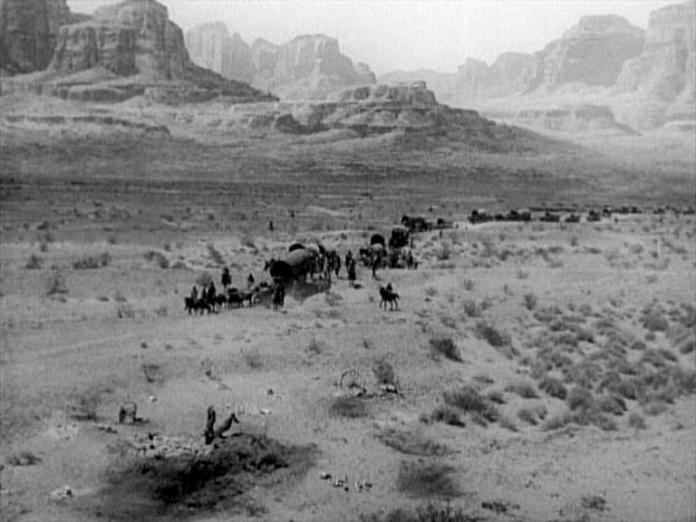
.
Director: Raoul Walsh
By Roderick Heath
One of the first true epics of sound cinema, The Big Trail left a deep and permanent imprint on movie history without a lot of people knowing about it. The late 1920s saw the cinema forcibly redefined by the advent of sound, a ruction for audiences, filmmakers, and theatre owners alike. True colour film processes would arrive soon after, but most filmmakers shied away from any further innovation until television forced them to fight for an audience. When they did, they would turn to the widescreen format, which had been introduced unsuccessfully in the 1920s. In France, Abel Gance’s Napoleon (1927) had demonstrated the artistic potency of the format, and three years later, The Big Trail came at the leading edge of another, brief campaign to promote the format in American filmmaking.
.
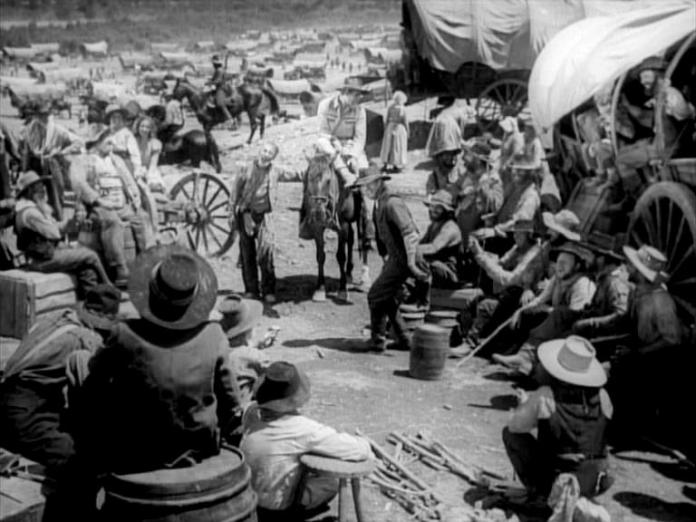
.
A mammoth undertaking by the Fox Film Corporation, The Big Trail was shot, incredibly, in six different versions simultaneously: editions in four alternate languages, a standard 35mm format version, and another in an experimental 70mm widescreen process called Grandeur. The exhausting labour and cost involved in this reflected the cumbersome demands of the era’s technology, and came on top of a colossal, already difficult location shoot that trailed nearly 2,000 miles across five states. Fox may have hoped to maximise the film’s box office potential by making so many versions, but instead The Big Trail became a sad failure, as most exhibitors refused to take up the widescreen format and the regular-sized print couldn’t make enough money to cover the huge expense during the straits of the early Depression.
.
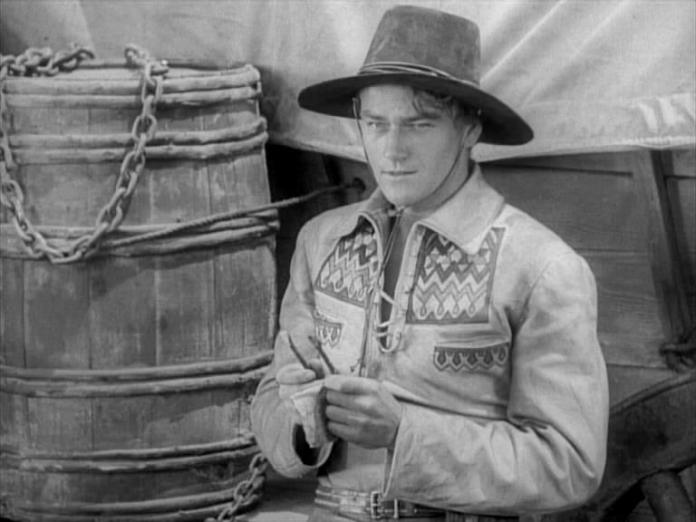
.
The Big Trail languished in relative obscurity for a long time as a result, whilst the similar, but far creakier Cimarron would capture the Best Picture Oscar a year later. Director Raoul Walsh took a blow to his career and wouldn’t get to helm another film of such a scale for some time. The new male star he had discovered for the project would languish in small roles and B westerns for nearly a decade. That young man, a former college footballer and bit-part player, was recommended to Walsh by mutual friend John Ford, who liked the actor’s cocky walk. He came on The Big Trail’s set named Marion Morrison, but thanks to Walsh and a cadre of studio executives, continued his career under the name they chose for him—John Wayne.
.
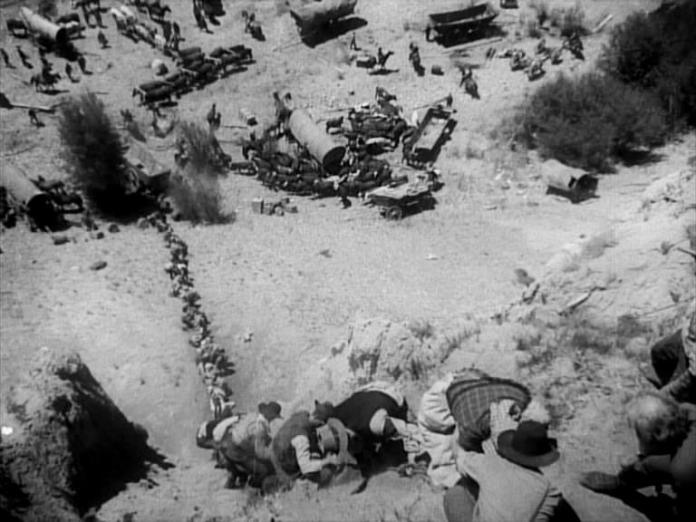
.
Walsh himself had been a rough-and-tumble cowboy actor in the pioneering days of Hollywood and dabbled in directing even before he appeared in D.W. Griffith’s The Birth of a Nation (1915), including work on the legendary docudrama The Life of General Villa (1913), starring the great bandit-revolutionary as himself. Walsh evolved into one of the most sublimely rigorous and no-nonsense of classical Hollywood filmmakers. With The Big Trail, he matched Lewis Milestone’s work on All Quiet on the Western Front (1930) in freeing early sound film from its stagy reflexes to discover the world at large. For Walsh, this discovery resulted in a relative crudeness, with dialogue recorded out in the open and sometimes muffled by a general clamour, but also fascinatingly rich and with a lively naturalism quite different to the smoother, but more artificial textures that would become the norm.
.

.
As a film, The Big Trail shows its age in places, but its general vigour and expanse is still breathtaking. As a depiction of the travails of early pioneers, it still dwarfs many amongst generations of imitations. The plot is merely sufficient to lend the film a through-line that sustains the panoramic study in a human tide on the move. Wayne plays frontiersman Breck Coleman, a product of life in the western expanses, one who credits his knowledge of hunting and exploring to the Native American tribes he grew up amongst. Coleman knows the land and can clear a path across the country for a huge wagon train forming at a trading post in Missouri, intending to be the first such large expedition to go across the country to claim farm land in Washington state. At first, Coleman is uninterested in joining the expedition because he’s on the hunt for the killers of his friend, Ben Griswold; someone tried to make the crime look like an Indian raid, but Breck looked closer and found signs revealing the true culprits, including the stub of a burnt-out cigar. Whilst he tells another old friend, Zeke (Tully Marshall) about this, Red Flack (Tyrone Power Sr.), the man hired to lead a cattle team ahead of the wagons and blaze the Oregon Trail, overhears him and is clearly rattled. Breck finds he leaves behind the same brand of cigar in his wake. Walsh employs a brief flashback to illustrate the processes of Breck’s deduction, revealing his discovery of Griswold’s last camp site in the wilderness and his comprehension of a masked crime. As he probes further, Breck discovers a large quantity of pelts probably stolen off Griswold were sold to the trading post by a man named Lopez (Charles Stevens), who happens to be a friend and employee of Flack.
.

.
Breck agrees to scout for the wagon train so he can stick close to this suspect pair and see if he can dig up more evidence and bring them to whatever kind of justice the moment provides. Meanwhile, he accidentally antagonises some of his prospective charges. He mistakes proper Southern belle Ruth Cameron (Marguerite Churchill) for another girl he knows and plants a kiss on her, only to realise his mistake as she stomps off in an offended huff. Ruth is the daughter of a greatly respected Southern elder, but she’s set on building a new life with her brother Dave (David Rollins) and younger sister. She has a self-appointed guardian and would-be suitor of traditionally gallant credentials, Bill Thorpe (Ian Keith), who claims to be a plantation owner looking for adventure and tries repeatedly to talk Ruth into marrying him. He exchanges pithy words with Breck, as the young man tries to apologise to Ruth—except that Thorpe is actually a gambler who can’t stay at the trading post lest he be hung and can’t go back lest he be shot thanks to excessive displays of his prodigious skills with firearms. But he’s friends with Flack, and he joins the wagon train with an eye to netting Ruth and taking out Breck as a favour to his pal. Breck tries to do his job whilst avoiding Thorpe’s various attempts to kill him, barely surviving one ambush in which his horse is killed. Meanwhile, Breck negotiates safe passage through Cheyenne territory with their chief, Black Elk (John Big Tree), but danger waits as other native nations join in a coalition to block their path through the Rocky Mountains.
.
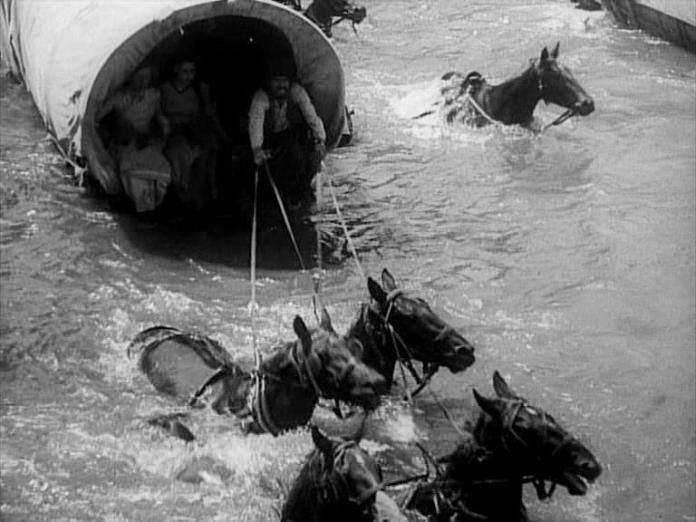
.
The basic storyline is familiar genre melodrama and mostly serves to give a little sinew to what is otherwise a survey of frontier experience, a depiction of a communal event that strays legitimately into the true definition of epic as an account of the social flux and great undertaking that creates a nation. Walsh records this with such elaborate detail and rhythmic intensity that he creates a virtually pantheistic work of art. Although there’s a brief patch of speechifying towards the end, when Breck underlines the overall meaning of the event, Walsh is for the most part happy to let his images speak—visions of prairie schooners rocking along in clouds of dust under the rays of the setting sun, his characters traversing rivers and mountains and forests. The unusual, laborious shoot meant that The Big Trail comes close in nature to one of Robert Flaherty’s staged documentaries simply by the unavoidable authenticity of much on screen, the peculiar thrill of such moments as the wagons being lowered with improvised cranes down a cliff face and trying to negotiate a swollen river. The vast number of extras look unusually like the kind of people they’re portraying. Walsh delights in zeroing in on sights like strong, muscular woman chopping down trees and lashing along their oxen amongst the broad diorama of human activity, this moving city in the wilderness, all achieved without recourse to tricks like back projection.
.
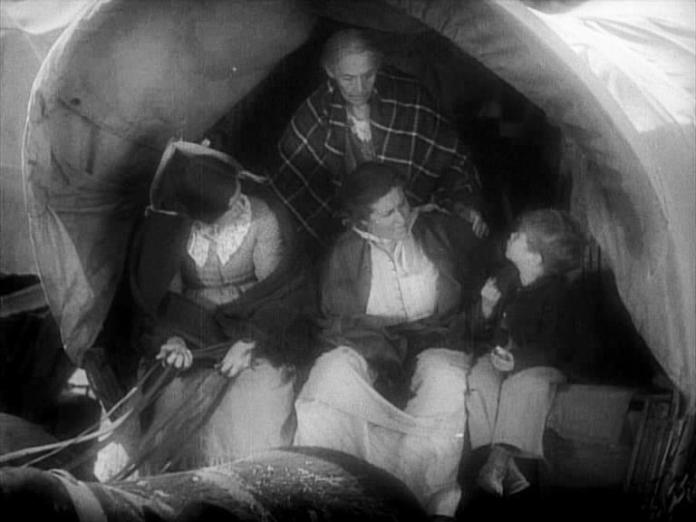
.
The admiration for the pluck of ordinary men and women is typical of Walsh, who stayed in the Hollywood game as a jack-of-all-trades but made his clearest mark in Warner Bros. plebeian melodramas, like They Drive By Night (1940) and Manpower (1941), and films with sociological breadth, like The Bowery (1933) and The Roaring Twenties (1939), the latter a particularly potent influence on subsequent waves of filmmakers from Orson Welles to Martin Scorsese. Walsh could handle any genre, but found real focus in gangster and war films. Where his great rivals in the classic cadre of macho auteurs Ford, DeMille, and Hawks, tended towards mythologising in their different ways, Walsh, like William Wellman, retained something of a reportorial attitude, comprehending the shifts from the plucky energy of the ’30s to a despair over the illusions of the American dream (The Roaring Twenties), the defeat of individualism (High Sierra, 1941), the neurotic birth of the atomic age (White Heat, 1949), and overtures of fascist power and resistance in the burgeoning Cold War (The Naked and the Dead, 1958). The Big Trail, meanwhile, feels like a preparatory sketch for those canonical Western epics, Hawks’ Red River (1948) and Ford’s The Searchers (1956), whilst How the West Was Won (1963) is a partial remake. Like Red River, The Big Trail watches an intimate drama play out in the midst of a massive undertaking, and neither can resolve until the end of the trail is reached. Like The Searchers, the quest to write a form of justice and human meaning upon an impassive and voraciously expansive landscape and the need for safe harbours and human connection remain in constant tension.
.
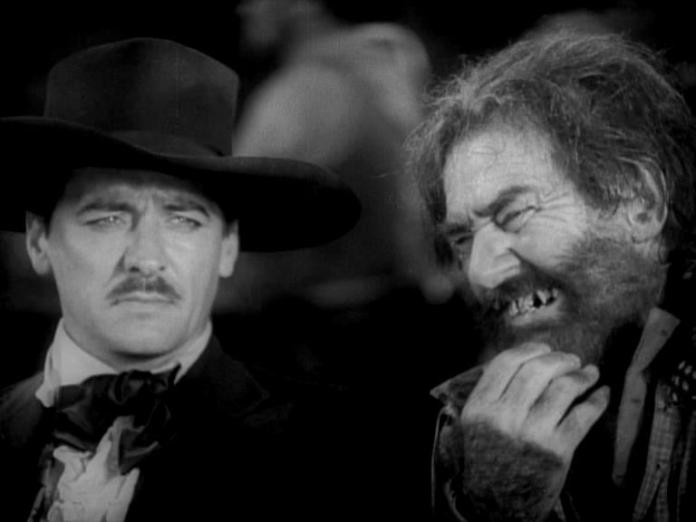
.
The drama in The Big Trail is much more elemental than what Walsh usually offered, but it’s rewarding to look closely at Thorpe and Flack, a divergent pair of characters united by the fact they’re both nefarious criminals, forming with Lopez a kind of shadow society within the greater enterprise. Thorpe is a fake gentleman, slick and charismatic, precursor to John Carradine’s similar, if more ambiguous character in Stagecoach (1939) but also a type for whom Walsh might later have offered far more sympathy as the man who can’t submit to a society bent on ironing out wrinkles like him, dogged by his impulses towards nobility rather than merely using that attitude as a disguise. Indeed, by the time of White Heat, Walsh would reveal the processes of empathy completely inverted: the psychotic, desperate Cody Jarrett had become the hero and the man quietly shadowing him to bring him to justice the villain. Keith has lean charisma in the role of Thorpe, and he would later become a favourite actor of DeMille’s. Flack is a monstrous brute who nonetheless has great reserves of native cunning and authority, and reportedly provided the direct inspiration for Popeye’s Bluto. Power, a former matinee idol as his then-teenage son would become, looked gnarled and terrible by this time. With bushy beard, snaggy, rotten teeth, and belly-deep, broken-bottle voice, he creates an unsubtle, but galvanising villain, like some kind of prehistoric monster born aberrantly in human form. Both Thorpe and Flack represent fading varieties of authority, the raw force of the barbarian king and the deceptively lethal self-interest of the pseudo-aristocrat who wants to be taken for a slave-owning oligarch, men who tellingly “lead” the expedition but don’t actually do much for it.
.

.
Interestingly, Walsh would later combine the Thorpe and Flack characters to create his unstable antiheroes who waver between nobility and base violence, particularly White Heat’s Cody Jarrett and The Naked and the Dead’s Sgt. Croft, who, like Flack, is an ancient kind of he-man who leads his team on an epic mission but with more Melvillian overtones per Norman Mailer’s source novel. Meanwhile Walsh pulls apart the presumptions of a film he starred in, The Birth of a Nation; note that Ruth is, like the central family of that film, a Cameron, but is running away from her legacy following the telling death of the old patriarch and the loss of property and standing. Thorpe mentions that there “isn’t a home in all the South that wouldn’t be happy to take in the daughter of Colonel Cameron” (notably, much later Walsh would take on the legacy of slavery more pointedly in A Band of Angels, 1957). By contrast, Breck is the egalitarian son of the frontier who doesn’t fear a fight. but also easily negotiates with the Indians he understands and with whom he shares a worldview. Meanwhile, Ruth’s brother Dave takes the place of another character Walsh was fond of, the fresh-faced neophyte anxious to take his place amongst men. Walsh also plays with his camera and storytelling methods: the flashback to Breck’s discovery of Griswold’s camp counts as an unusual touch for the time, whilst Walsh’s way of shooting the fleet of prairie schooners, including a shot from inside one wagon as it negotiates the land, surely influenced Ford’s work on Stagecoach.
.
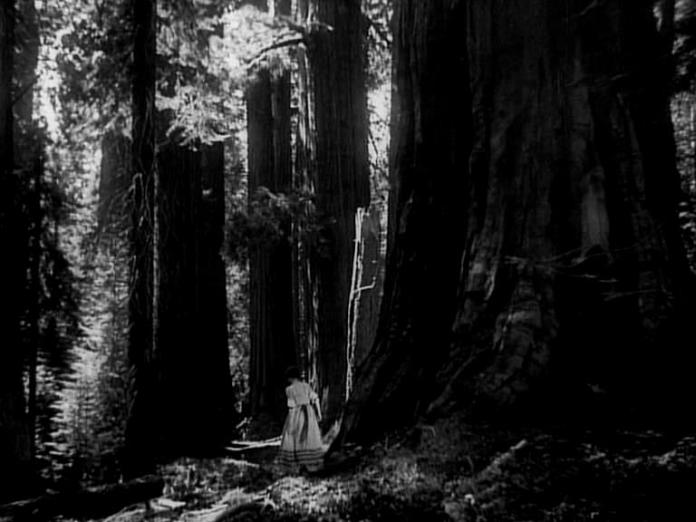
.
The photography by Lucien Andriot and Arthur Edeson is remarkably alive to physical texture—the grains of wood in the fixtures of the wagons seem almost alive—whilst hinting at some larger spirit in their visuals, found in rays of sunlight gushing through clouds over the convoy, and the bone-chilling final hunt sequence in the forest at the extremes of mortality. Walsh’s grasp on orchestrating massive action and hordes of extras and the precision of his flow of vignettes, suggests what he learnt from Griffith, as well as the relentless logic of his horizontal compositions. But even as he contends with some hokey comedy and the simplicity of the story, Walsh has left the Victorian sentiments of Griffith far behind: here there are only strong and hardy people contending with the land. The soundtrack captures a constant clamour of juddering wheels and rattling pots and lowing cattle, the ambient din of the wagon train, with enriching authenticity, the kind of effect that would later be commonplace, but here still has a quality of discovery. The final sequences, filmed in the midst of California’s awe-inspiring redwoods, sees the wagon train climb down from soaring white mountains to verdant valley floors fringed by the great trees, underlining a feeling of having passed into some mythical realm where gigantism is a norm and everything is touched with a dusting of mythology. Critic Fred Camper tellingly saw The Big Trail it as an epic where the place of the individual human was displaced by nature at the heart of the film, and this often feels quite true, laying seeds for the ways later generations of filmmakers like Werner Herzog, Terrence Malick, and Alejandro Gonzalez Iñárritu would attempt a similar sensitisation to environment as character.
.

.
Walsh might also have been taking a few ideas from the trickle of Soviet Realist films in the way he plays down individuals in favour of observing group action with an intensive eye for their way of life. Interpolated title cards reinforce the heroic bluster in the film’s take on the colonising event, but for much of its length, The Big Trail actually takes a droll, even laid-back approach to the human level. Breck and Ruth’s thorny romance is played mostly for light comedy as Ruth remains superficially cold to Breck’s ardent attempts to romance her. Ruth obeys a programmed cultural loyalty that sees her gravitating to Thorpe in spite of all warning signs, whilst even the Comanche who come along for the ride can recognise their budding relationship, labelling her “Coleman’s Squaw” to her extreme aggravation. Some of the humour verges on silly, particularly as Zeke’s drinking buddy, Windy Bill (Russ Powell), ruffles Thorpe’s savour faire as he tries to romance Ruth by making animal noises. El Brendel contributes his patented comic Swede act for some gags that were probably hoary at the time, contending with his rather perturbingly large, forceful mother-in-law and at one point, sitting in a mud puddle only to explain the mud’s so deep he’s actually still on top of his horse. The sight of Zeke and Windy drunk as lords as they set out on the great expedition does a lot to dent the grandiosity with a sense of human scruffiness. Ruth decides to leave the wagon train with Thorpe after feeling humiliated by the jokes of the pioneers and Indians, and Thorpe decides to try to complete his job for Flack by taking a chance to gun down Breck before departing.
.
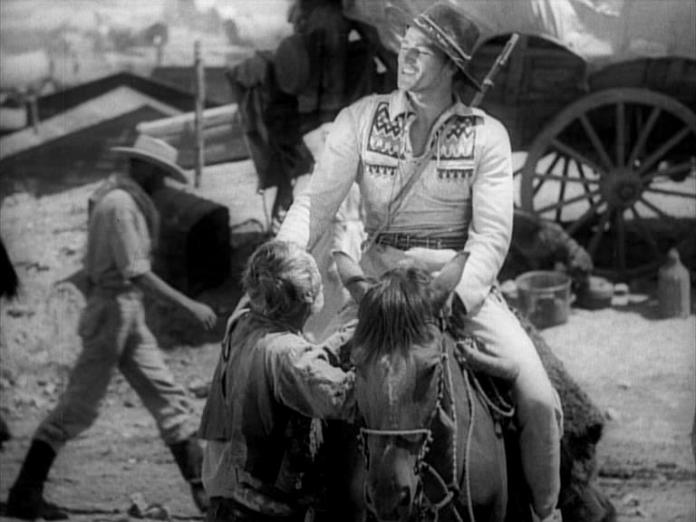
.
Lucky for Breck that Zeke keeps an eye out for him and plugs Thorpe as he’s taking aim at Breck’s back. This sparks a brief travail for Breck as Ruth, misinterpreting what Dave reports of the event, accuses Breck of murder, an accusation Flask tries to take advantage of. Fortunately, Zeke intervening to set the record straight and an Indian attack head off trouble for Flack. The settlers circle their wagons and battle off the massed attackers. Breck still can’t prosecute his vengeance against Flask and Lopez, not until they make a move as the convoy nears its destination and the necessity of stopping him before he can bring in outside authorities grows urgent. It’s truly fascinating to see Wayne here at the very start of his career, easily commanding the screen as a leading man in spite of his youth and tenderfoot status. Gary Cooper was initially commissioned to play Breck, and it’s easy to see at this time why Wayne would be taken as a substitute, just as tall but still fairly rangy, dashingly handsome in a way hard to associate with his older, craggier visage. It’s clear from the first moment what a different screen persona he wields compared to Cooper’s cagey intensity, with his hearty laughter and easy stride and yawing line deliveries. Cooper often played characters adapted to a rugged life in a cautious and thoughtful way, whereas Wayne just seems to belong in this world, body and soul. There’s still something boyish to Wayne here, his looks rather foxy and his voice ringing a little higher, accentuated by the old Vitaphone sound recording, that’s particularly appealing. Some of the half-suppressed playfulness filmmakers like Ford and Henry Hathaway could get out of Wayne later is evident here, particularly in the scene when he accidentally kisses Churchill’s Ruth with a young masher’s energy.
.
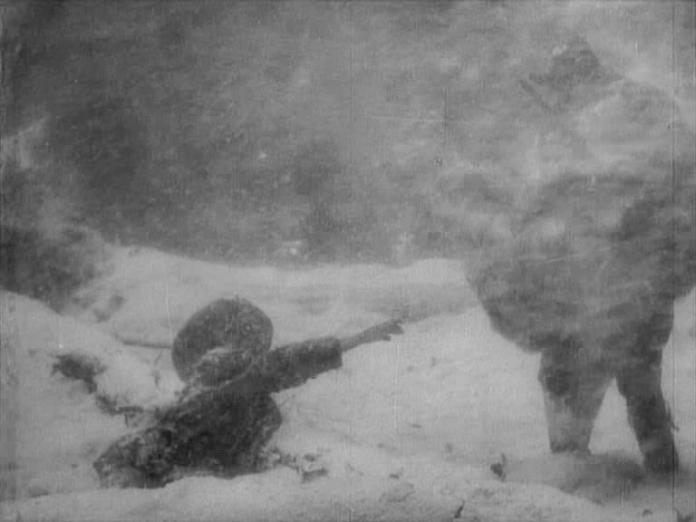
.
Churchill is less engaging, though she handles well the crucial moments when she finally gives up trying to hold in her feelings for Breck and begs him not to go after Flack and Lopez, and she has a certain pithy tilt of chin and flash of eye that repeatedly demonstrates that under the remnant façade of the prim Southern belle, Ruth is a hardy, worthy lady. Walsh was particularly great when it came to vivid action finales for his films, pushing push them to perfect visual and thematic nexus images—the church steps at the end of The Roaring Twenties, the battle on the electrical wires in Manpower, the exploding gas tank in White Heat—and The Big Trail builds to a spellbinding vignette high in a snowy forest where Lopez collapses and freezes to death whilst Flack forges on, only for Breck to catch up with him with the two men oblivious to each other on either side of a colossal, toppled redwood stem. Snow billows, light shafts, the flash of Breck’s knife blade, a gunshot, and death, Flack’s huge body collapsing by the fallen tree, another titan of an age about to meet civilisation’s at once revolutionary and withering touch. When Breck and Ruth are reunited, Walsh returns to the midst of the colossal redwoods, like organ pipes for a colossal cathedral of nature, climaxing in a final shot tilting up along another giant redwood, this one growing and titanic, to the sun far above. The images here haunted me for months after first watching the film, as if Walsh had captured the essence of a time and place that never quite existed, the fantastic world every dreamer reaches for. The Big Trail might not have found the stature it deserved in its time, but it testifies to the great power the medium could wield even as its very nature changed.
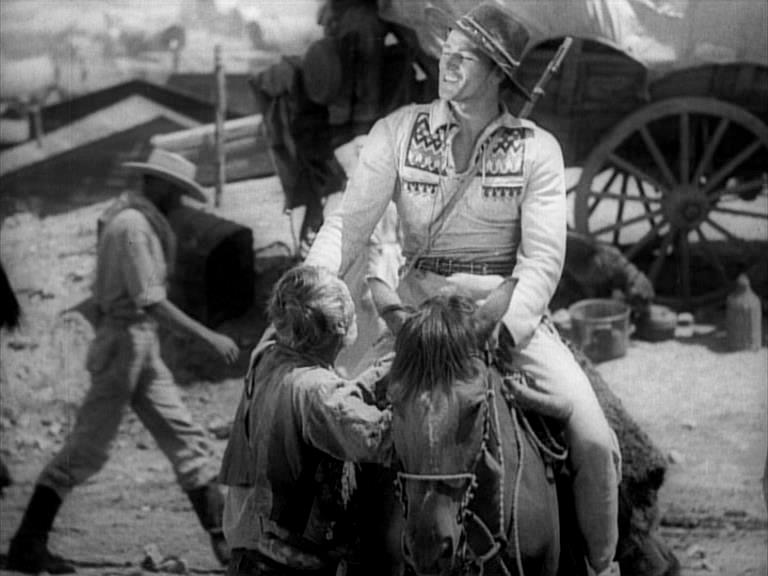
That’s a terrific analysis of the film. It’s not a perfect movie by any means and Wayne is far from the finished article. However, it does look incredibly impressive at times and is further evidence of how well Walsh could present a story.
LikeLike
This is a good write-up, but I have to note that Raoul Walsh did not simply “dabble in directing” in the 1910s. He directed a few dozen films in that decade, and although most are lost, the evidence suggests he was one of America’s major directors. REGENERATION, released the same year as BIRTH OF A NATION, points more directly to the emerging classical style than Griffith’s film; I think it’s a better work, and John Ford cited it as a favorite.
LikeLike
Epic review of a movie I only just saw last year on my 42″ LG. Would love to see it up on The Big Screen. Thanks, Ferry, for all you do for film.
LikeLike
If Big Trail often seems archaic it’s all to its advantage. Somehow if feels more like a product of the time it’s set in rather than 1930, and I wouldn’t want any of the performers to be more polished. When you look at this and The Bat Whispers it feels tragic that widescreen didn’t catch on back then. At least Walsh finally got another chance at a widescreen western and delivered The Tall Men. And add the mountain finale of High Sierra to your canon of his great climaxes.
LikeLike
Colin: I can’t fault Walsh’s work at all. It’s masterfully handled, with something beautifully lucid to the flow of vignettes. It never feels episodic or thinly plotted even though when you look closely it’s both. If there’s a flaw to the film, I think it’s that it can’t quite commit to its plot developments, like having the tension over whether Flack can pin Thorpe’s death on Breck deflated so quickly. Wayne might not be so polished as he would be, but I like seeing him that way, filled with cool energy long before he threatened to get pompous. In that regard he’s Hollywood filmmaking in general from the time.
JMH: I’m sorry my use of the word dabbling wasn’t worshipful enough for you. Nobody doubts the quality of Walsh’s early work although I also suspect he like many actors after him moved into directing carefully and found it his real metier.
Wim: We please to aim. I too would love to see this on a big screen – the widescreen version too if possible.
Samuel: yes, that weird quality like you’re looking into a time machine is often present. I think it’s because the cast so obviously has a lot people in it who weren’t actors or extras but ordinary people netted for the production. They just look like the same breed. And yes, High Sierra (and the variation on it in Colorado Territory as well) is another great ending.
LikeLike
This is the best write-up of this movie I’ve ever seen. I saw it a year or two back and found it a fascinating historical document, but felt the dramatic plot was a bit undercooked. I loved the scenery and Wayne’s performance, though. But this essay makes me want to watch it again.
I did feel the interpersonal romance/narrative had been done before quite prominently, though, in John Ford’s The Iron Horse. That film also starred a young embodiment of the frontier who scouts for a westward expedition, romances a girl above him in station, and searches for a killer who took out a father firgure and framed it on Indians. The bad guy is an oily aristocrat–though a businessman rather than a Southern gentleman–who is also trying to get the girl, and he brings an Indian attack down on them that the hero might have prevented with diplomacy, but must finally fight off by circling up in an epic battle sequence. (If I recall correctly, at least.) It seems weird not to mention it. Though I guess this might have been seen in other silent westerns I haven’t seen as well, such asThe Covered Wagon. Regardless, I found The Iron Horse a more fleet and exciting movie, with better action sequences, but this film the more impressively large-scaled.
LikeLike
Stephen, I haven’t seen The Iron Horse so I can’t comment on it, although I did wonder if it influenced this, as it seemed like a natural reference point for Walsh and his connection to Ford. In any event, glad you liked the write-up. I enjoy this film enormously, obviously. Yes, the story development is a bit undercooked, but I don’t mind that so much, as the panoramic quality of the drama is most interesting here, I feel.
LikeLike
“JMH: I’m sorry my use of the word dabbling wasn’t worshipful enough for you. ”
Not sure what occasioned the nasty tone here. I was just pointing out that Walsh was a major director by the mid-teens. If you haven’t seen REGENERATION, it’s magnificent.
LikeLike
Actually it was an attempt at humour, JMH, employed because I got the impression from your comment that you felt I was slighting Walsh’s early work which was the opposite of my intentions. My apologies if it fell flat. I have seen parts of Regeneration and they were very good.
LikeLike